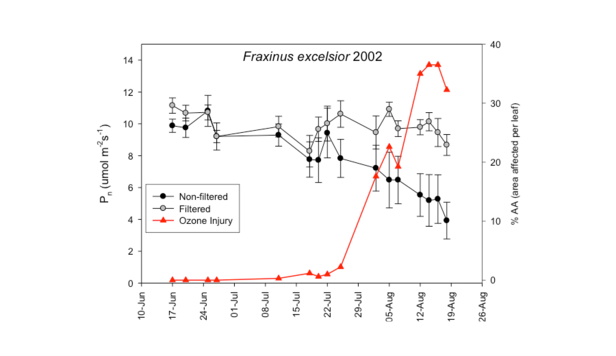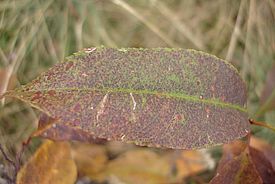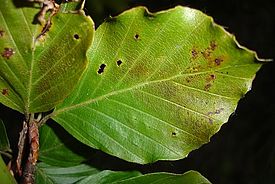Ozone (O3) leaves no chemical residues whose content could be analyzed or analytically quantified. Therefore, visible leaf and needle symptoms are the only evidence that can be relatively easily detected and characterized and that can provide valuable information about the effect of ozone on plants.
Since 1993, typical symptoms of ozone damage have been observed in more than 80 plant species in Switzerland. Many other species from Spain, Italy and other countries showing symptoms have been described.
The damage could have negative consequences for the growth and vitality of the trees. Although widespread forest dieback due to ozone seems highly unlikely, it is beyond doubt possible that high ozone concentrations weaken forest stands.
Following a protocol developed by ICP Forests, an international programme on air pollution and its effects on the forest, we record ozone symptoms every year in late summer at the forest edge on selected LWF sites.

Contact ¶
Publications ¶
For further information on the influence of ozone on the growth of trees, please read:
- Cailleret M, Ferretti M, Gessler A, Rigling A, Schaub M (2018) Ozone effects on European forest growth - towards an integrative approach. Journal of Ecology, 106, 4: 1377-1389. doi: 10.1111/1365-2745.12941
- Schaub M, Calatayud V, Ferretti M, Brunialti G, Lövblad G, Krause G, Sanz MJ (2016) Part XV: Monitoring of Air Quality. In: UNECE ICP Forests Programme Co-ordinating Centre (ed.): Manual on methods and criteria for harmonized sampling, assessment, monitoring and analysis of the effects of air pollution on forests. Thünen Institute of Forest Ecosystems, Eberswalde, Germany, 11 p. + Annex [http://icp-forests.net/page/icp-forests-manual] ISBN: 978-3-86576-162-0.

